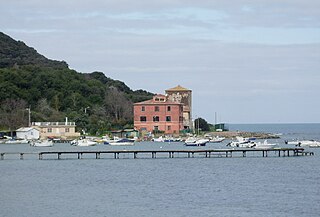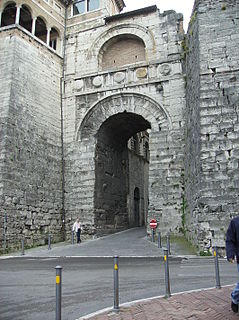 W
WAcquarossa or Fosso Acqua Rossa is the modern name of the location of an ancient Etruscan settlement abandoned or destroyed in the second half of the sixth century BC. Located near Viterbo, in Etruria, was excavated by the Swedish Institute at Rome in the 1960s and 1970s. An elite complex similar to the Regia in Rome was excavated at the site.
 W
WAtri is a comune in the Province of Teramo in the Abruzzo region of Italy. Atri is the setting of the poem The Bell of Atri by American writer Henry Wadsworth Longfellow. Its name is the origin of the name of the Emperor Hadrian.
 W
WBaratti is a village frazione of the comune of Piombino in the Province of Livorno, with roughly only 15 residents.
 W
WBlera is a small town and comune in the northern Lazio region of Italy. It was known during the Middle Ages as Bieda, an evolved form of its ancient name, which was restored in the twentieth century. It is the birthplace of Pope Sabinian; Pope Paschal II was also originally thought to be from here.
 W
WCastellina in Chianti is a comune (municipality) of c. 2,800 inhabitants in the province of Siena, in the Italian region Tuscany, located about 35 kilometres (22 mi) south of Florence and about 15 kilometres (9 mi) northwest of Siena. It is part of the Chianti Hills, between the valleys of the Arbia, Pesa and Elsa rivers.
 W
WThe Etruscan Arch or Arch of Augustus or Augustus Gate is one of eight gates in the Etruscan wall of Perusia, known today as Perugia. It is one of the only two surviving gates along with the Porta Marzia to the south. It was constructed in the second half of the 3rd century BC and was restored by Augustus in 40 BC after his victory in the Perusine War. Representing the best surviving and most monumental of the Etruscan city gates it opens onto the cardo maximus of the city, corresponding to the modern Ulisse Rocchi Road.
 W
WEtruria was a region of Central Italy, located in an area that covered part of what are now Tuscany, Lazio, and Umbria.
 W
WThe Etruscan Well, also known as "Sorbello well" from the name of the noble family which still owns the mansion which includes the structure, is located in the old town of Perugia. Entrance to the well, currently open to the public as a museum, is from no. 18 piazza Danti, through a covered walkway which leads to the underground sections of Palazzo Sorbello.
 W
WFerentium was a town of ancient Etruria, situated near the modern city of Viterbo in the northern part of the Roman province of Latium, now in modern Lazio. The city was also known as Ferentinum, Ferentum or Ferentia, and should not be confused with ancient Ferentinum, which is in southern Lazio.
 W
WFiesole is a town and comune of the Metropolitan City of Florence in the Italian region of Tuscany, on a scenic height above Florence, 5 km northeast of that city. The Decameron by Giovanni Boccaccio is set in the slopes of Fiesole. The city was equally featured in the novels Peter Camenzind (1904) by Hermann Hesse and A Room with a View (1908) by E. M. Forster, and in the book of travel essays Italian Hours (1909) by Henry James.
 W
WFregenae, was a maritime town of ancient Etruria, situated between Alsium and the mouth of the Tiber. The modern Fregene is an Italian hamlet (frazione) of Fiumicino, in the Metropolitan City of Rome, Lazio. As of 2012 its population was of 6,445.
 W
WGravisca was the port of the Etruscan city of Tarquinii, situated 8 km west of the city center.
 W
WLake of the Idols is a lake located in Arezzo Province, Tuscany, Italy. It is located 1,380 metres (4,530 ft) above sea level atop Monte Falterona, about 600 metres from the source of the river Arno. Situated near an ancient road linking Etruria with the Adriatic port cities of Romagna, it is known for one of the largest archaeological finds of the Etruscan civilization; over 600 bronze statuettes of Etruscan and Roman origin, along with thousands of other figurines from Cisalpine Gaul and Umbria, were discovered within the lake.
 W
WMusarna is an Etruscan settlement located approximately 10 km west of Viterbo, Italy. The site was discovered in 1849 and has been the site of excavations carried out by the École française de Rome since 1983.
 W
WThe ancient Perusia, now Perugia, first appears in history as one of the 12 confederate cities of Etruria. It is first mentioned in the account of the war of 310 or 309 BC between the Etruscans and the Romans. It took, however, an important part in the rebellion of 295 BC and was reduced, with Vulsinii and Arretium (Arezzo), to seek for peace in the following year.
 W
WPoggio Civitate is a hill in the commune of Murlo, Siena, Italy and the location of an ancient settlement of the Etruscan civilization. It was discovered in 1920, and excavations began in 1966 and have uncovered substantial traces of activity in the Orientalizing and Archaic periods as well as some material from both earlier and later periods.
 W
WPoggio Colla is an Etruscan archaeological site located near the town of Vicchio in Tuscany, Italy.
 W
WPopulonia or Populonia Alta today is a frazione of the comune of Piombino. As of 2009 its population was 17. Populonia is especially noteworthy for its Etruscan remains, including one of the main necropolis in Italy, discovered by Isidoro Falchi.
 W
WThe sanctuary of Minerva at Portonaccio is an archaeological site on the western side of the plateau on which the ancient Etruscan city of Veii, north of Rome, Italy, was located. The site takes its name from the locality within the village of Isola Farnese, part of Municipio XX, city of Rome.
 W
WPyrgi was an ancient Etruscan port in Latium, central Italy, to the north-west of Caere. Its location is now occupied by the borough of Santa Severa.
 W
WRofalco was a fortified late-Etruscan settlement, located about twenty km north of Vulci, at the edge of the Selva del Lamone volcanic plateau. The site controlled the important natural route formed by the valley of the Olpeta stream and contributed to the defense and the organization of the southeastern portion of the ancient territory of Vulci.
 W
WSan Giovenale is the modern name of the location of an ancient Etruscan settlement close to the modern village of Blera, Italy. It was excavated by the Swedish Institute at Rome in the 1950s and 1960s with King Gustaf VI Adolf as one of the participating archaeologists. The excavations at San Giovenale has been, together with the excavations of Acquarossa, the main source of information about how small and medium-size Etruscan settlements were organized. The finds from the excavations are now partly exhibited in the Etruscan Museum of the Rocca Albornoz in Viterbo.
 W
WSpina was an Etruscan port city, established by the end of the 6th century BCE, on the Adriatic at the ancient mouth of the Po, south of the lagoon which would become the site of Venice.
 W
WUmbertide is a town and comune (township) of Italy, in the province of Perugia and in northwestern Umbria, at the confluence of the Reggia river and the Tiber. It is 30 km (19 mi) North of Perugia and 20 km (12 mi) South of Città di Castello. With 16,607 inhabitants according to the 2017 census, Umbertide is one of the larger towns of Umbria; and basically flat. It is an industrial center producing machine tools, textiles, packaging material, and ceramics. Olive oil is produced, especially in Pierantonio and in its southwestern part.